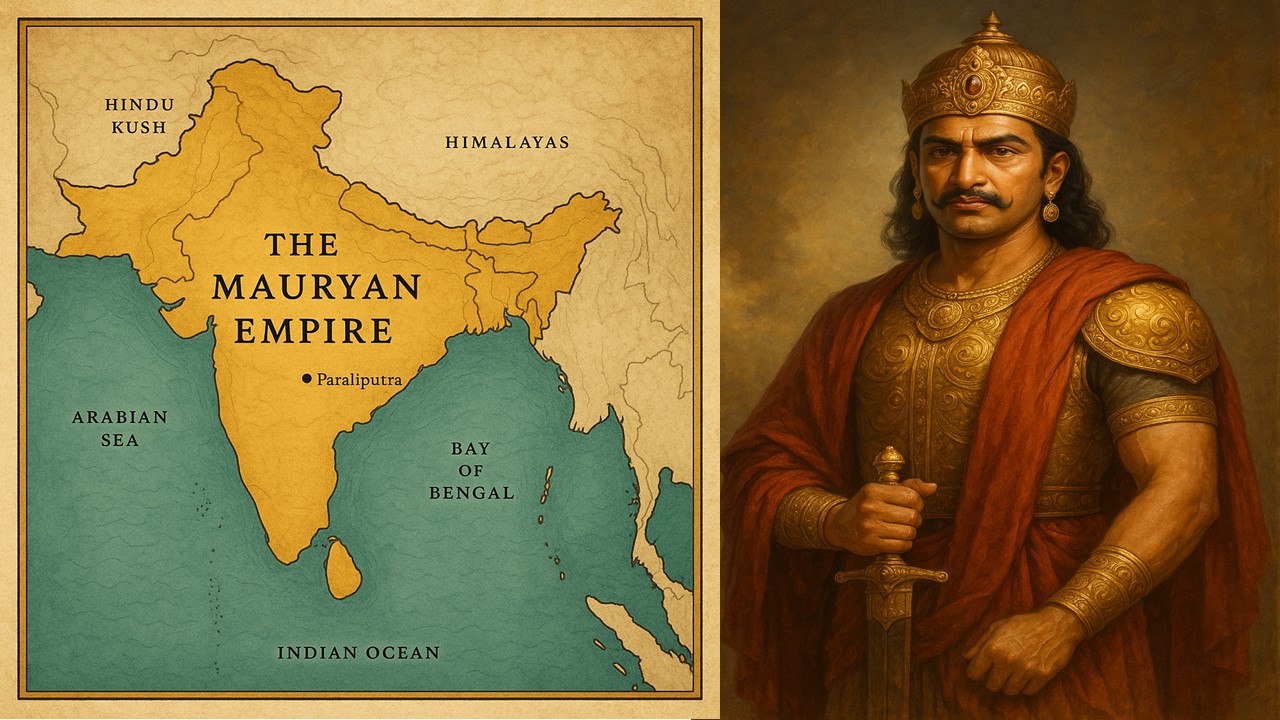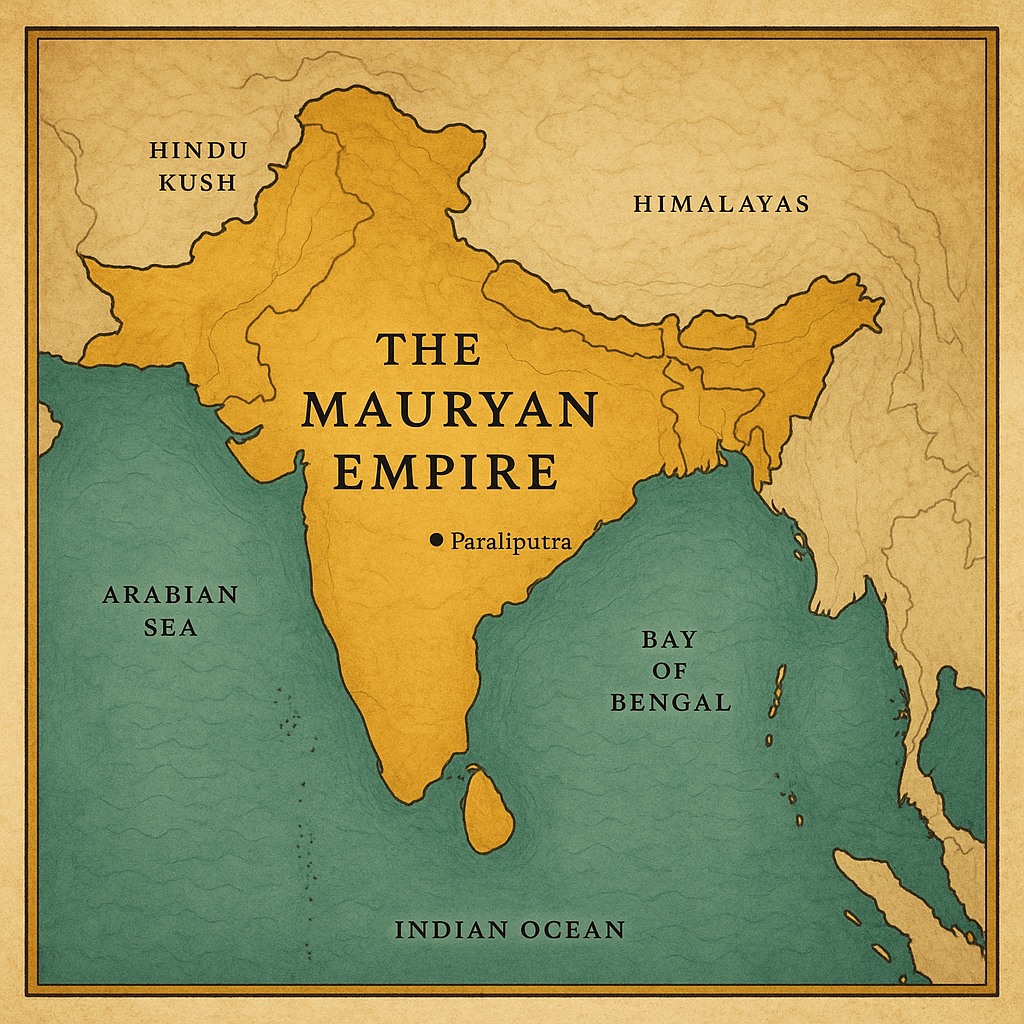
Chandragupta Maurya: The Warrior Who United India
Discover the remarkable rise of Chandragupta Maurya, India’s first emperor, who united a vast nation with vision, strategy, and courage
Introduction
In the grand saga of India’s history, few names shine as brightly as Chandragupta Maurya – the first emperor to unify most of the Indian subcontinent under one rule. From humble beginnings to becoming the founder of the Maurya Empire around 321 BCE, Chandragupta’s story is one of ambition, war, wisdom, and transformation.
A Humble Beginning
Born in Magadha (modern-day Bihar) in modest circumstances, Chandragupta was not of royal blood. Raised among ordinary people, his leadership qualities and courage stood out even at a young age.
Legend has it that he was discovered by Chanakya (also known as Kautilya), a brilliant strategist and teacher at Takshashila University. Chanakya saw in him the potential to overthrow the corrupt Nanda dynasty and build a powerful Indian empire.

The Rise of a Warrior King
Guided by Chanakya’s political acumen and vision, Chandragupta began assembling an army. He united small kingdoms, inspired peasants to fight, and adopted guerrilla tactics to weaken the mighty Nanda forces.
Eventually, around 321 BCE, he defeated Dhana Nanda, the last Nanda ruler, and established the Mauryan Empire — marking the beginning of a new era in Indian history
A Vast and Powerful Empire
Once in power, Chandragupta didn’t stop. He turned his eyes toward Alexander the Great’s former territories in the northwest, defeating the Seleucid forces and expanding the empire to modern-day Afghanistan, Pakistan, and India.
Under his leadership, the Mauryan Empire became one of the largest and most organized empires in ancient India — known for its efficient administration, infrastructure, and a powerful army.
Governance and Legacy
Chandragupta’s rule was deeply influenced by Chanakya’s Arthashastra, a treatise on politics, economics, and military strategy. He established a centralized government, strong spy network, and robust trade routes.
Later in life, Chandragupta embraced Jainism, renounced his throne, and spent his final years in Karnataka as a monk — a remarkable transformation from a warrior to a seeker of peace.
Chandragupta Maurya’s achievements laid the foundation for a united India and paved the way for future legends like Ashoka the Great, his grandson.
He was the first Indian ruler to prove that unity in diversity was possible — that an empire could be built not just with the sword, but with vision and wisdom.
From Village Boy to Visionary Leader
Many centuries ago, a boy was born in Magadha (modern Bihar), with no royal title, no palace, and no army — just dreams. That boy was Chandragupta Maurya, who would one day rise to power and change India forever.
He caught the attention of Chanakya, a brilliant teacher and political thinker, who saw greatness in him. Together, they planned to overthrow the corrupt Nanda dynasty and create a united India.
The Fall of a Dynasty
Chandragupta trained hard, built alliances, and led a rebel army. With Chanakya’s strategy and his courage, they defeated King Dhana Nanda around 321 BCE. Chandragupta became king — and founded the Maurya Empire.
This was the first time most of India was brought under one ruler.
Building an Empire
After taking Magadha, Chandragupta pushed west. He battled and defeated the Greek generals left behind after Alexander the Great and claimed parts of today’s Afghanistan and Pakistan.
His empire stretched across almost all of the Indian subcontinent — one of the largest in Indian history.
Rule with Wisdom
Chandragupta ruled with discipline and intelligence. He followed the advice in Arthashastra, written by Chanakya, to run his empire:
- Strong spy system
- Strict law and order
- Smart taxation and trade
- Public welfare and development
His rule brought stability and progress to India for the first time at such a grand scale.
From Emperor to Monk
After years of ruling, Chandragupta gave up his throne and became a Jain monk. He moved to Karnataka, lived a simple life, and died peacefully — proving that true greatness lies in humility.
A Legacy That Lives On
Chandragupta Maurya was more than a conqueror. He proved that leadership, vision, and unity could transform a land divided by kingdoms into a single, powerful nation. His grandson, Ashoka, would carry forward this legacy.
Conclusion
Chandragupta Maurya’s journey from an unknown village boy to India’s first emperor is more than just a story — it’s a legacy. He changed the course of Indian history forever, proving that courage, intellect, and determination can truly move empires.
Who was Chandragupta Maurya?
Chandragupta Maurya was the founder of the Mauryan Empire and the first emperor to unify most of India under one rule around 322 BCE. He rose from humble beginnings with the guidance of Chanakya (Kautilya).
What was the Mauryan Empire?
The Mauryan Empire (322 BCE – 185 BCE) was the first major empire in India, known for its large size, centralized governance, and rulers like Chandragupta and Ashoka the Great.
Who was Chanakya (Kautilya)?
Chanakya was a teacher, economist, and strategist who helped Chandragupta rise to power. He authored the Arthashastra, a famous treatise on politics, economics, and warfare.
What was the capital of the Mauryan Empire?
The capital of the Mauryan Empire was Pataliputra, located in modern-day Patna, Bihar.
How did Chandragupta Maurya come to power?
Chandragupta, with the help of Chanakya, overthrew the Nanda dynasty and established his rule in Magadha, eventually expanding the empire across the subcontinent.
What areas did the Mauryan Empire cover?
At its peak, the Mauryan Empire included most of India, parts of Pakistan, Afghanistan, Bangladesh, and Nepal.
Why is Chandragupta Maurya important in Indian history?
He was the first ruler to unify India under one administration and laid the foundation for a centralized empire that promoted governance, economy, and military strength.
Did Chandragupta Maurya follow any religion?
Later in life, Chandragupta embraced Jainism, renounced his throne, and lived as a Jain monk in Karnataka.
Who succeeded Chandragupta Maurya?
His son, Bindusara, succeeded him, followed by his grandson Ashoka the Great, who became one of India’s most revered rulers.



